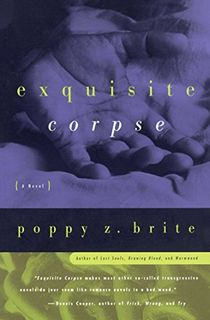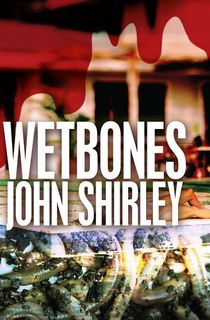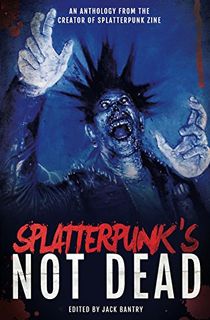First coined by author and editor David J. Schow at the Twelfth World Fantasy Convention in Providence in 1986, the term “splatterpunk” is derived, in part, from “splatter films”—which was already in use to describe particularly gory horror movies.
“Splatterpunk” came to encompass a horror movement that was a revolt against “traditional horror narratives, which rely on suggestion and implication to instill unease. How? By showing everything.”
Writing in the Globe and Mail, Warren Clements defines splatterpunk as a “literary genre characterized by graphically described scenes of an extremely gory nature.” At the same time, elsewhere it has been called “hyperintensive horror with no limits.”
What is Splatterpunk?
Perhaps the best definition, however, comes from Brian Keene, himself an author of no shortage of splatterpunk tales.
“If it’s transgressive, addressing social or political ills, not pulling punches, and pushing the boundaries,” Keene told Fangoria, “then it’s splatterpunk.”
Among the best-known names associated with splatterpunk are Clive Barker, Poppy Z. Brite, Jack Ketchum, John Skipp and Craig Spector, Kathe Koja, Keene himself, and others—many of whom will be found on this list of splatterpunk books that are must-reads for those who are looking to get into one of horror’s most extreme subgenres.
But fair warning: splatterpunk tales often aim to “remove the limits of society and so-called good taste. All the limits.” This means that splatterpunk frequently treats offensive topics, and does not always do so carefully.
Even leaving that aside, most of these books aren’t for the weak of heart… or the weak of stomach.
Must-Read Splatterpunk Books

Books of Blood
“I have seen the future of horror and his name is Clive Barker,” Stephen King famously said after this Liverpudlian author made his literary debut with the six short story collections that make up The Books of Blood.
Few other debuts have ever had such a seismic impact on a genre as The Books of Blood, in which demons, serial killers, severed hands, cannibals, plagues, pigs, magicians, and so much more all explode onto the page with gruesome results.
To say that splatterpunk would not exist without The Books of Blood is an understatement. To say that modern horror would not exist without it is probably more accurate.

Exquisite Corpse
Described by the author as “a necrophilic, cannibalistic, serial killer love story that explores the seamy politics of victimhood and disease,” Poppy Z. Brite’s Exquisite Corpse kind of has it all, where splatterpunk is concerned.
Based partly on real-life serial killers including Dennis Nilsen and Jeffrey Dahmer, Exquisite Corpse takes readers from London’s Piccadilly Circus to the French Quarter of New Orleans, all through the eyes of a cadre of killers and outcasts in what Peter Straub has hailed as “a guidebook to hell.”

The Girl Next Door
Most of the writers on this list have produced a range of works that could all qualify as must-read splatterpunk, and Jack Ketchum is no exception.
Probably his most controversial book, however, is The Girl Next Door, with its vivid, visceral, and haunting depictions of torture, sexual abuse, and more.
Making things all the more chilling, The Girl Next Door is a fictionalized retelling of a real case, the horrifying death of 16-year-old Sylvia Likens, who was brutalized, tortured, sexually assaulted, and starved by her caregiver, as well as various neighborhood children.
Adapted into the 2007 film of the same name, The Girl Next Door remains a tough read, even today.

The God of the Razor
Over a long and prolific career, Joe R. Lansdale has dipped his toes into any number of genres and subgenres, from weird westerns to crime stories and beyond.
That includes splatterpunk, which he deftly visits in this collection of short stories and one early novel, which Publishers Weekly hailed as setting “new standards for the depiction of graphic violence” while also proclaiming it “probably the best novel of its type between Psycho and The Silence of the Lambs.”
Along with the novel, this collection features several short stories along similar lines, including characters who appeared alongside Batman, and a story that was adapted to the screen by Don Coscarelli as part of the Showtime series Masters of Horror.

Wetbones
“The queasies’ll getcha if you don’t watch out!” raved Kirkus Reviews of this splatterpunk classic by John Shirley, which tracks several lost souls through a grisly katabasis into the underworld of the City of Angels as they stalk or are stalked in turn by a more-than-human serial killer who leaves his victims as nothing but piles of wet bones.
From drug-addled parties to sexual murders to astral vampires and the excesses of the Hollywood elite, just about anything that you might imagine in a splatterpunk novel can be found in Wetbones, which “combines the monstrous inventiveness of H. P. Lovecraft with the exquisite excess of Clive Barker.”

The Cipher
Winner of both the Bram Stoker and Locus Awards, Kathe Koja’s unforgettable novel is “a stone-cold landmark of the genre” (Josh Malerman, author of Bird Box).
When Nicholas and Nakota find a strange black hole in a storeroom in Nicholas’ apartment, the terror begins. Dubbed the “Funhole,” anything that goes into the hole comes back… changed.
Experimentation leads to obsession, and obsession leads to bizarre, bloody body horror in this unforgettable debut that helped to kick off the Dell Abyss line of horror books, which contained more than its fair share of splatterpunk titles.

Splatterpunk's Not Dead
Back in 1990, Paul M. Sammon edited an anthology called Splatterpunks: Extreme Horror which served as a sort of rallying point for the subgenre.
While those older anthologies may be out of print, however, as the title of this new collection of stories curated by the editor of Splatterpunk Zine suggests, Splatterpunk’s Not Dead.
You can see this in eight new tales by voices on the ragged, bloody edge of modern horror, including Adam Cesare (Clown in a Cornfield), Jeff Strand, and many more.





